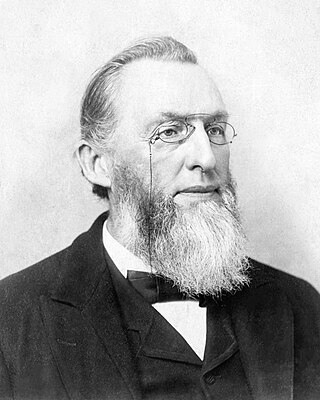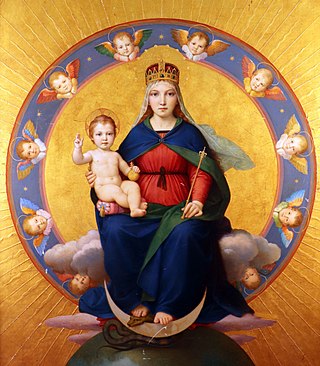Related Research Articles
Christian eschatology is a minor branch of study within Christian theology which deals with the doctrine of the "last things", especially the Second Coming of Christ, or Parousia. Eschatology – the word derives from two Greek roots meaning "last" (ἔσχατος) and "study" (-λογία) – involves the study of "end things", whether of the end of an individual life, of the end of the age, of the end of the world, or of the nature of the Kingdom of God. Broadly speaking, Christian eschatology focuses on the ultimate destiny of individual souls and of the entire created order, based primarily upon biblical texts within the Old and New Testaments.

Eschatology concerns expectations of the end of the present age, human history, or the world itself. The end of the world or end times is predicted by several world religions, which teach that negative world events will reach a climax. Belief that the end of the world is imminent is known as apocalypticism, and over time has been held both by members of mainstream religions and by doomsday cults. In the context of mysticism, the term refers metaphorically to the end of ordinary reality and to reunion with the divine. Religions treat eschatology as a future event prophesied in sacred texts or in folklore. While other religions may have concepts of renewal or transformation after significant events, the explicit description of a new earth is primarily found in Christian teachings within the context of eschatology, this description can be found in Chapter 21 of the Book of Revelation.
In Christian eschatology, the Great Tribulation is a period mentioned by Jesus in the Olivet Discourse as a sign that would occur in the time of the end.
The Millerites were the followers of the teachings of William Miller, who in 1831 first shared publicly his belief that the Second Advent of Jesus Christ would occur in roughly the year 1843–1844. Coming during the Second Great Awakening, his teachings were spread widely and grew in popularity, which led to the event known as the Great Disappointment.
The Great Disappointment in the Millerite movement was the reaction that followed Baptist preacher William Miller's proclamation that Jesus Christ would return to the Earth by 1844, which he called the Second Advent. His study of the Daniel 8 prophecy during the Second Great Awakening led him to conclude that Daniel's "cleansing of the sanctuary" was cleansing the world from sin when Christ would come, and he and many others prepared. When Jesus did not appear by October 22, 1844, Miller and his followers were disappointed.

Apocalyptic literature is a genre of prophetical writing that developed in post-Exilic Jewish culture and was popular among millennialist early Christians. Apocalypse is a Greek word meaning "revelation", "an unveiling or unfolding of things not previously known and which could not be known apart from the unveiling".
The Prophecy of Seventy Weeks is the narrative in chapter 9 of the Book of Daniel in which Daniel prays to God to act on behalf of his people and city, and receives a detailed but cryptic prophecy of "seventy weeks" by the angel Gabriel. The prophecy has been the subject of "intense exegetical activity" since the Second Temple period. James Alan Montgomery referred to the history of this prophecy's interpretation as the "dismal swamp" of critical exegesis.
Bible prophecy or biblical prophecy comprises the passages of the Bible that are claimed to reflect communications from God to humans through prophets. Christians usually consider the biblical prophets to have received revelations from God.

Futurism is a Christian eschatological view that interprets portions of the Book of Revelation, the Book of Ezekiel, and the Book of Daniel as future events in a literal, physical, apocalyptic, and global context.
In Christian eschatology, historicism is a method of interpretation of biblical prophecies which associates symbols with historical persons, nations or events. The main primary texts of interest to Christian historicists include apocalyptic literature, such as the Book of Daniel and the Book of Revelation. It sees the prophecies of Daniel as being fulfilled throughout history, extending from the past through the present to the future. It is sometimes called the continuous historical view. Commentators have also applied historicist methods to ancient Jewish history, to the Roman Empire, to Islam, to the Papacy, to the Modern era, and to the end time.

Manuel De Lacunza, S.J. was a Jesuit priest who used the pseudonym Juan Josafat Ben-Ezra in his main work on the interpretation of the prophecies of the Bible, which was entitled The Coming of the Messiah in Majesty and Glory.

Uriah Smith was a Seventh-day Adventist author, minister, educator, and theologian who is best known as the longest serving editor of the Review and Herald for over 50 years.

The Seventh-day Adventist Church holds a unique system of eschatological beliefs. Adventist eschatology, which is based on a historicist interpretation of prophecy, is characterised principally by the premillennial Second Coming of Christ. Traditionally, the church has taught that the Second Coming will be preceded by a global crisis with the Sabbath as a central issue. At Jesus' return, the righteous will be taken to heaven for one thousand years. After the millennium the unsaved cease to exist as they will be punished by annihilation while the saved will live on a recreated Earth for eternity.
The theology of the Seventh-day Adventist Church resembles that of Protestant Christianity, combining elements from Lutheran, Wesleyan-Arminian, and Anabaptist branches of Protestantism. Adventists believe in the infallibility of Scripture and teach that salvation comes from grace through faith in Jesus Christ. The 28 fundamental beliefs constitute the church's official doctrinal position.
The day-year principle or year-for-a-day principle is a method of interpretation of Bible prophecy in which the word day in prophecy is considered to be symbolic of a year of actual time. It was the method used by most of the Reformers, and is used principally by the historicist school of prophetic interpretation. It is held by the Seventh-day Adventist Church, Jehovah's Witnesses, and the Christadelphians. The day-year principle is also used by the Baháʼí Faith, as well with by most all astrologers who employ the "Secondary Progression" theory, aka the day-for-a-year theory, wherein the planets are moved forwards in the table of planetary motion a day for each year of life or fraction thereof. The astrologers say that the four seasons of the year are directly spiritually, phenomenologically like the four "seasons" of the day.

The Woman of the Apocalypse is a figure–often considered to be a reference to the Virgin Mary in Catholic theology–described in Chapter 12 of the Book of Revelation.

The four kingdoms of Daniel are four kingdoms which, according to the Book of Daniel, precede the "end-times" and the "Kingdom of God".
Horae Apocalypticae is an eschatological study written by Edward Bishop Elliott. The book is, as its long-title sets out, "A commentary on the apocalypse, critical and historical; including also an examination of the chief prophecies of Daniel illustrated by an apocalyptic chart, and engravings from medals and other extant monuments of antiquity with appendices, containing, besides other matter, a sketch of the history of apocalyptic interpretation, the chief apocalyptic counter-schemes and indices."
The name Palmoni appears in the original Hebrew in the biblical book of Daniel. The still widely used King James Version of 1611 refers to Palmoni indirectly as "that certain saint" – "or," as a marginal note from the translators says, "the numberer of secrets, or, the wonderful numberer: Heb. Palmoni."
Historicism is a method of interpretation in Christian eschatology which associates biblical prophecies with actual historical events and identifies symbolic beings with historical persons or societies; it has been applied to the Book of Revelation by many writers. The Historicist view follows a straight line of continuous fulfillment of prophecy which starts in Daniel's time and goes through John of Patmos' writing of the Book of Revelation all the way to the Second Coming of Jesus Christ.
References
- ↑ "The Prophetic Year".
- ↑ "Foundations of the Seventh-day Adventist Message and Mission".
- ↑ "360 Day Prophetic Year".
- ↑ Seventh-day Adventists Believe (2nd ed). Ministerial Association, General Conference of Seventh-day Adventists. 2005. pp. 184–185. ISBN 1-57847-041-2.
- ↑ "The Prophetic Year".
- 1 2 Anderson, Robert "The Coming Prince". Pages 74–75 of the 10th Edition
- ↑ Fleming, Robert Jr. The Rise and Fall of Papacy (1801). 1848 edition, page 34